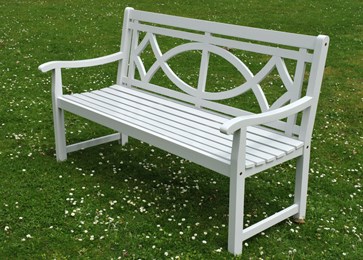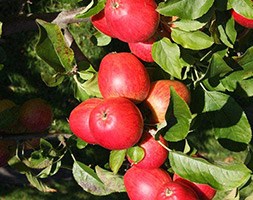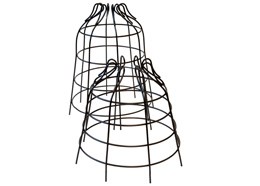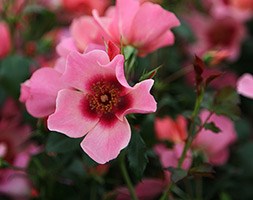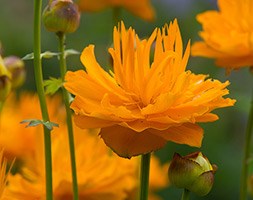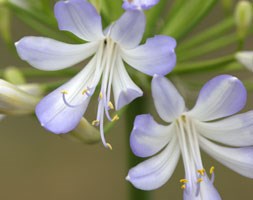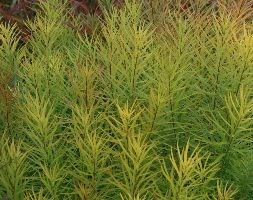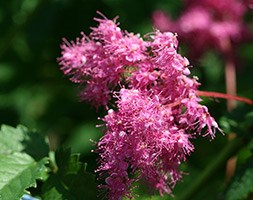New products at Crocus
by Sarah - July 11th, 2014.Filed under: Crocus, New Products.
Crocus has these new products today
Paxton bench – cool grey £199.99
Another classic bench for the garden made from FSC Eucalyptus, coated with a satin cool grey powder coat. It will fit well into any garden and add a touch of character and a lovely place to sit and contemplate. This item is supplied partly assembled, It is relatively easy to build with bolts and all the tools you need to put it together. Dimensions: Total Height: 92cm Length from arm rest to arm rest: 149cm Length of the seat: 143cm Width of seat: 49cm Distance from floor to seat: 43cm With ALL outdoor furniture the ideal scenario is to cover the items up with a water proof cover or sheet if you are going to leave it outdoors over the winter months.
apple ‘Little Pax’ (apple) £39.99
Position: full sun Soil: fertile, well-drained soil Rate of growth: average Ultimate size on MM106 rootstock: 5.5 x 5.5m (18 x 18ft) Flowering period: April and May Hardiness: fully hardy Pollination Group: Garden care: Keep the base of the tree weed free, fertilise at the beginning of each year and water regularly during hot, dry spells. Remove damaged or crossing branches during the dormant season. Pollination Information:
Plant support cage £29.99
These classic shaped plant supports are good for more upright perennials and shrubs with arching stems in your borders such as Paeonies, Delphiniums, Hydrangeas and Spiraea. It is made from forged iron, powder coated dark brown to protect it outdoors. Produced from coated steel rod. Measurements: Squat: Height 42cm, Diameter 44cm Tall: Height 59cm, Diameter 44cm
Dome plant support – green £29.99
These come in two sizes. They are a great idea for protecting young or established plants in your borders from being trampled on. The plants are able to grow up through the wire which will act as a plant support for mound forming perennials. You can group some of the domes at the front of the border to create a barrier against larger mammals such deer, dogs and foxes. The domes are soon covered by foliage and will be hidden, becoming a subtle detail in the garden. Produced from coated steel rod. Measurements: Small: Height 28cm, Diameter 26cm Large: Height 41cm, Diameter 63.6cm
Rosa For Your Eyes Only (‘Cheweyesup’) (PBR) (Rose of the Year 2015) £19.99
Position: full sun Soil: fertile, humus-rich, moist, well-drained soil Rate of growth: fast-growing Flowering period: June to September Other features: excellent disease resistance Hardiness: fully hardy Voted as Rose of the year for 2015, this repeat flowering floribunda rose will flower continuously throughout the summer if deadheaded regularly. It is the result of over 30 years selective breeding. All our roses are grown in an open field and then dug up when the weather conditions are right in October or November. Some suppliers send out their roses as ‘bare root’ plants (ie without pots or compost), but we pot ours up as it helps to keep the roots hydrated and in good condition. As they are dormant throughout the winter, they will not produce any new roots until spring, so don’t be surprised if the compost falls away from the roots when you take them out of their pots. The roses can be kept in their pots throughout the winter provided they are kept well fed and watered, however ideally they should planted out as soon as possible. They will already have been cut back so no further pruning will be required, apart from snipping off any tips that have died back. Routine pruning can begin in late winter the year after planting. Garden care: If planting in winter, choose a frost-free spell when the soil is not frozen. Roses are quite deep-rooted plants so dig a deep hole roughly twice as wide as the plants roots and mix in a generous amount of composted organic matter. A top-dressing of a general purpose fertiliser can be worked into the surrounding soil and we also recommend using Rose Rootgrow at this stage to encourage better root development. This is particularly important when planting into a bed where roses have previously been grown as Rose Rootgrow is said to combat rose sickness (aka. replant disease). Remove the plants from their pots and gently spread out the roots before placing them in the centre of the hole. Try to ensure that the ‘bud union’ (the point where the cultivated rose has been grafted onto the rootstock, and from where the shoots emerge) is at soil level. You can judge this quite easily by laying something flat, like a spade handle or bamboo cane, across the top of the hole. When they are at the right height, back-fill the hole, firming the soil down gently before watering the plant well. Water generously until well established, and apply a special
Trollius ‘Dancing Flame’ (globeflower) £9.99
Position: full sun or partial shade Soil: moisture-retentive, fertile soil Rate of growth: average Flowering period: April to June Hardiness: fully hardy Garden care: Lift and divide large clumps in late autumn or early spring. In spring apply a 5-7cm (2-3in) mulch of well-rotted garden compost or manure around the base of the plants and water in very dry weather, to prevent the soil from drying out.
Agapanthus ‘Phantom’ (African lily) £8.99
Position: full sun Soil: fertile, moist, well-drained soil (or John Innes no. 3 compost for containers) Rate of growth: average Flowering period: August to September Hardiness: frost hardy (may need protection in winter) Lush strap-shaped leaves are retained in all but the coldest winters, making this a great choice for year-round interest. From late summer, they turn from merely interesting into something really fabulous, when their loose clusters of trumpet-shaped flowers appear on top of their elegant, slender stems. Each white bloom looks as though it has been infused with the softest shade of lilac-blue, so the overall effect is very refined. A beauty for the late summer garden. Garden care: Apply a balanced liquid fertiliser throughout the growing season. Keep reasonably dry during the winter and protect the crowns with a dry mulch in the autumn. Divide plants that have become too big in spring, but remember you will often get more flowers when the roots are constricted.
Amsonia hubrichtii (Arkansas blue star) £6.99
Position: full sun or partial shade Soil: moist, but well-drained soil Rate of growth: average Flowering period: May to July Hardiness: fully hardy As the name suggests, this plant originates from the area around Arkansas where it’s found in well-drained creek banks and surrounding lowlands. This variety has very narrow, needle-like leaves that stick out from the stems like a bottle brush. The distictive foliage creates a fine textured, billowing feel that forms a dense mass, similar to a small shrub. In early summer star-like, steel-blue flowers about 1cm across appear and are great for adding cool colour to a border. Long after the flowers have faded in autumn the foliage turns rich buttery shades before the plant dies back for its winter hybernation. Garden care: This plant does not like wet soil, especially during the winter, so make sure it is planted in a freely draining soil.
Filipendula rubra ‘Venusta’ (Queen of the prairies) £6.99
Position: full sun or partial shade Soil: moderately fertile, leafy, moist but well-drained soil. It also tolerates boggy conditions Rate of growth: average to fast Flowering period: June to July Hardiness: fully hardy In reliably moist soils, this is a fast growing perennial that will soon form a good-sized clump of handsome foliage. In early summer branching sprays appear, topped with deep pink feathery flowers, which fade to a softer pink as they age. It is an ideal choice for naturalising in an open woodland or meadow where there is a reliable source of water. Garden care: Apply a generous layer of mulch in spring.







